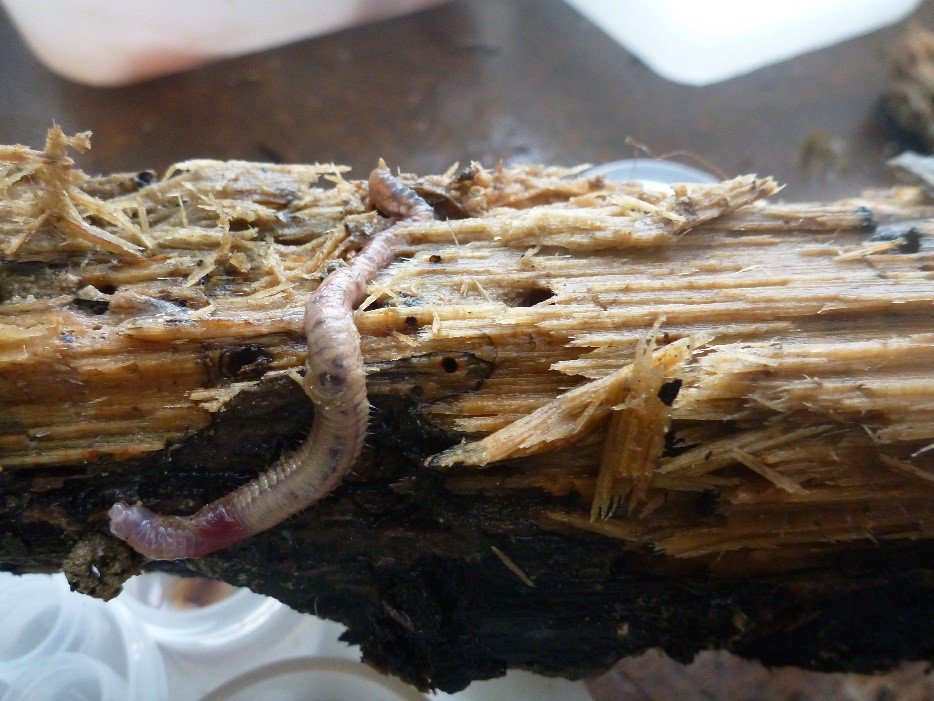Banana blood worms invade the deep sea
Blood worms occur in estuarine areas and are commonly used for bait by recreational fishers all around the world. In a world first, three new species of blood worm have been found in deep sea sunken vegetation, off the coast of Papua New Guinea. So how did these species evolve?
Until recently, blood worms (Marphysa spp.) have only been found in estuarine areas where they are dug up for fish bait, either for personal use or for commercial sale – making blood worms an extraordinarily valuable resource. In Australia, six species have been described and more are in the pipeline.
Dr Pat Hutchings, Senior Fellow at the Australian Museum, and Dr Nicolas Lavesque were amazed when sorting through deep water samples, collected in the Bismarck and Solomon seas off eastern Papua New Guinea, that they found three different species of Marphysa living in amongst banana leaves and dead wood.

Marphysa banana, anterior end, lateral view.
Image: Nicolas Lavesque© Nicolas Lavesque

Live specimen of Marphysa papuaensis, in dead wood.
Image: French Muséum National d’Histoire Naturelle (MNHN)© French Muséum National d’Histoire Naturelle (MNHN)
All the worms were collected from depths of 273-1200 metres during cruises operated by the French Institut de Recherche pour le Développement (IRD) and by the French Muséum National d’Histoire Naturelle (MNHN), in collaboration with the University of Papua New Guinea. These specimens were housed in the museum in Paris but some of these specimens are now housed in the Australian Museum marine invertebrates collection.
To date, no other species of Marphysa have ever been collected at such depths – there are 83 species known worldwide, with 15 known from the central Indo-Pacific. Typically, they are found in soft sediments in estuarine or shallow protected areas, at depths less than 10 metres.
This discovery (recently published by Pat, Nicolas and co-authors in Zookeys) raised the question of how these three unique species evolved. They are morphologically and genetically distinct from other Indo-Pacific species. The reason for this difference might relate to micro-environments. Following heavy storms, debris from rivers may have washed into the ocean, and pushed into deep-sea floor beds. Over time, this isolated environmental niche may have encouraged these unusual species to evolve. Currently, we have limited knowledge of intertidal and shallow-water bloodworm species in this region of Papua New Guinea or northern Australia, and there are no records of deep-water species of this genus off the east coast of Australia.
Superficially, all blood worms look similar. Careful inspection of the structure of their gills and bristle types can differentiate between the species. These three new species all have very different types of pectinate chaetae, but we have no idea how these chaetae evolved. Why does one species have chaetae with abundant teeth whereas another has only a few? For now, this is a mystery.

Examples of different types of pectinate chaetae as seen under the SEM, found in Marphysa species from Papua New Guinea.
Image: Nicolas Lavesque© Nicolas Lavesque

Marphysa papuensis SEM of anterior end showing restricted distribution of branchiae.
Image: Nicolas Lavesque© Nicolas Lavesque
Pat and Nicolas also undertook molecular studies and were able to obtain sequences from two of the new species. They form a discrete clade with a species M. regalis, which was found off the coast of Bermuda (Clade 1). This clade is very distant to Clade 2 (below) which includes all other species of Marphysa for which molecular data is available. Therefore, these new species from PNG are genetically distant from the Australian species for which we have molecular data (M. bifurcata, M. fauchaldi, M. kristiani, M. mullawa, M. pseudosessiloa). Far more molecular data is needed to completely resolve the relationships of the 83 known species to each other, and such a study may result in the splitting of the genus which was divided into groups by Fauchald (1970).

These bloodworms form a discrete clade with a species M. regalis, which was found off the coast of Bermuda (Clade 1). This clade is very distant to Clade 2 which includes all other species of Marphysa for which molecular data is available.
Image: Pat Hutchings and Nicolas Lavesque© Australian Museum
We hope that this study will encourage our colleagues working around the world to venture further offshore, especially where vegetation is washed out of rivers or the land and is pushed into deeper water by currents or storm events. This study continues to highlight the amazing diversity of worms that still need to be described in our region, even in such large worms which are highly prized for fish bait.
Dr Pat Hutchings, Senior Fellow, Marine Invertebrates, Australian Museum.
Dr Nicolas Lavesque, CNRS, Université de Bordeaux, Bordeaux INP, EPOC, UMR 5805, Station Marine d’Arcachon, Arcachon, France CNRS.
Acknowledgements
We would like to thank Sue Lindsay at Macquarie University for taking the SEM images for our team and all people involved in the MADEEP and KAVIENG expeditions.
More information:
Lavesque, N., Daffe, G., Glasby, C., Hourdez, S. and Hutchings, P. 2022. Three new deep-sea species of Marphysa (Annelida, Polychaeta, Eunicida, Eunicidae) 1 from Papua New Guinea (Bismarck and Solomon seas). Zootaxa 1122, 81-102. https://doi.org/10.3897/zookeys.1122.89990.

